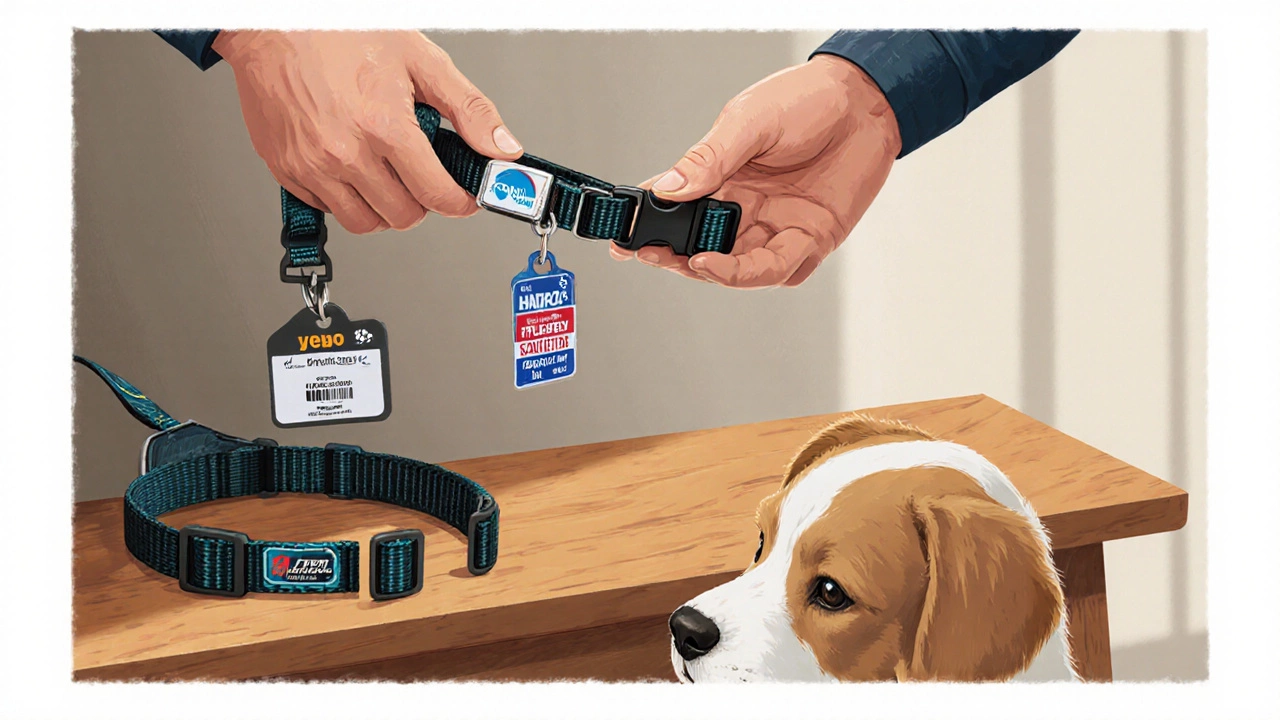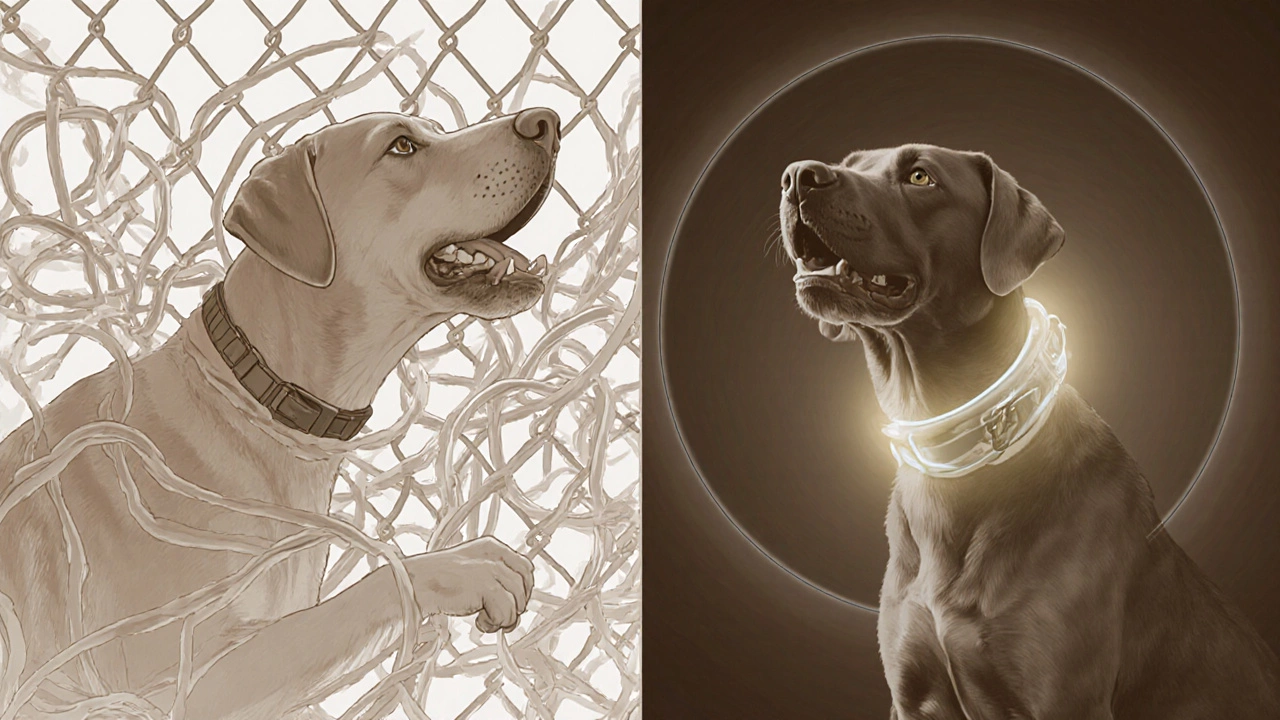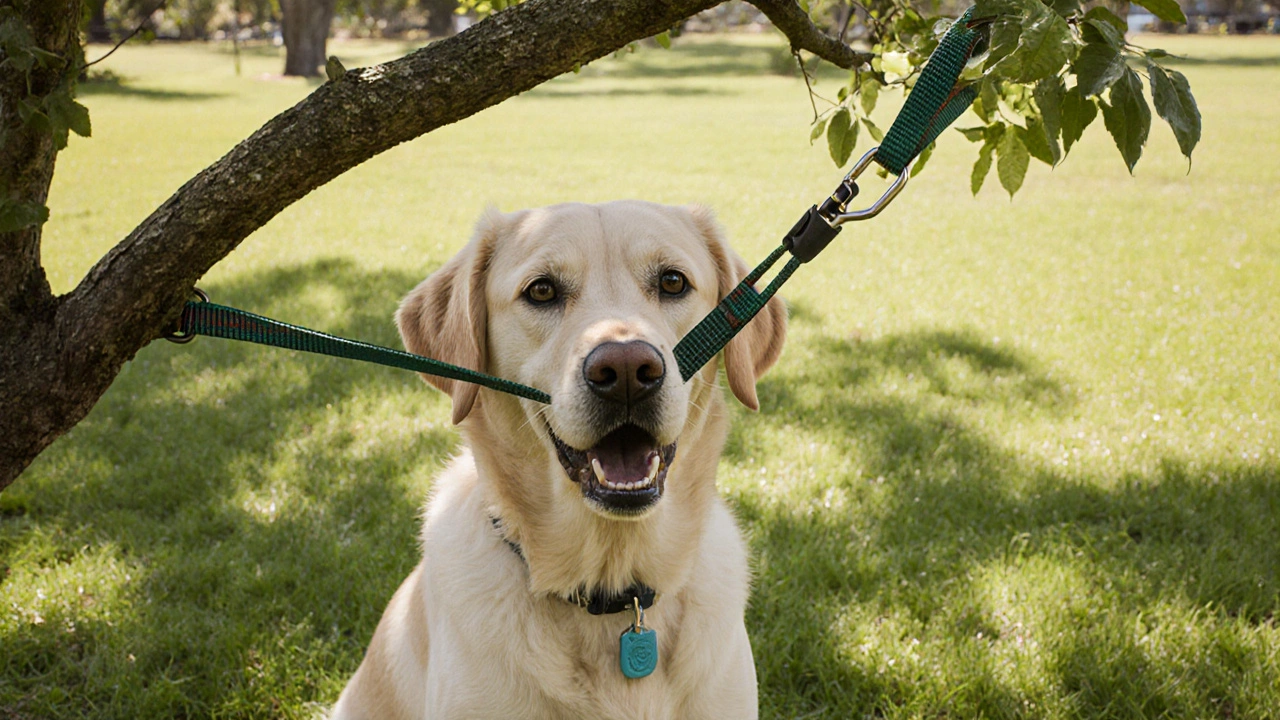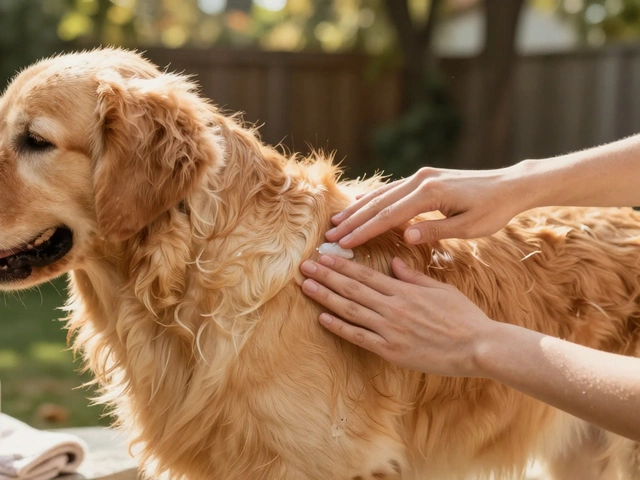Dog Collar Safety Assessment Tool
Is Your Dog Safe from Collar Injuries?
Answer these 5 quick questions to determine if your dog needs a breakaway collar for safety.
Every year in Auckland, dozens of dogs end up in emergency vet clinics because they got caught on something while wearing a regular collar. One owner told me her labrador nearly strangled himself after his collar snagged on a tree branch during a walk in Cornwall Park. He wasn’t hurt in the end, but the scare changed how she chooses gear for all three of her dogs. That’s the real reason breakaway collars matter - not because they’re trendy, but because they save lives.
What is a breakaway collar?
A breakaway collar is designed to snap open under pressure. Unlike standard buckles or fixed clasps, these collars have a safety release mechanism - usually a plastic or metal clasp that lets go when pulled with enough force. Think of it like a seatbelt that unlatches during a crash. It’s not meant to come off during normal walking or play. It’s meant to release when your dog’s collar gets caught on a fence, branch, crate, or another animal’s teeth.
These collars are often labeled as "safety collars," "escape collars," or "breakaway buckles." Some even have a small tag that says "Safety Release" right on the clasp. They’re commonly made from nylon or polyester, and the breakaway mechanism is built into the buckle, not the whole collar. That means the collar stays intact - it just opens when needed.
Why regular collars can be dangerous
Standard collars with plastic or metal buckles don’t give way. If your dog gets tangled - say, his collar catches on a low-hanging branch, a chain-link fence, or even another dog’s collar during rough play - he can’t pull free. That’s when choking, neck injuries, or panic set in. Dogs don’t understand how to back out of a snag. They panic. They pull harder. And that’s when things go wrong.
In 2023, the New Zealand Veterinary Association reported over 370 cases of collar-related injuries in dogs under the age of five. About 60% of those involved dogs wearing non-breakaway collars. Many of these dogs had bruised tracheas, swollen necks, or even collapsed windpipes from the constant pressure. One vet in Wellington told me she saw a poodle with a broken hyoid bone after his collar got stuck in a garden trellis. He survived, but it took surgery and weeks of recovery.
When breakaway collars are essential
Breakaway collars aren’t just for outdoor dogs. They’re critical for:
- Puppies - They’re curious, fast, and often get tangled in furniture, toys, or crates. Their necks are still developing, so even light pressure can cause harm.
- Indoor dogs - Dogs that roam freely in the house can get caught on curtain cords, bed frames, or pet gates. A breakaway collar can prevent a slow, terrifying strangulation.
- Dogs in multi-pet homes - If you have cats or other dogs, accidental collar snags during play are common. A breakaway collar lets your dog escape without injury.
- Dogs that wear ID tags - Yes, even if your dog has tags, a breakaway collar is safer. The tags don’t interfere with the release mechanism. You can still have your contact info on the collar - just make sure it’s attached with a split ring, not sewn on.
There’s a myth that breakaway collars are only for small dogs. That’s false. A 40kg Labrador can still get caught on something. Size doesn’t matter - the risk does.

When you shouldn’t use a breakaway collar
Breakaway collars aren’t for every situation. Don’t use them if:
- Your dog walks on a leash regularly - Breakaway collars aren’t designed for pulling. If you walk your dog on a leash, use a harness or a sturdy, non-breakaway collar designed for walking. The breakaway clasp can open mid-walk, and your dog could slip away.
- Your dog is a known escape artist - If your dog can wiggle out of any collar, a breakaway one might be too easy to escape from. In that case, use a well-fitted harness and a secure collar for identification only.
- You’re using it as a training collar - Breakaway collars aren’t meant for corrections, leash training, or choke chains. They’re for safety, not control.
Many owners make the mistake of using a breakaway collar for walks. That’s like using a fire extinguisher to water your plants - it’s the wrong tool for the job. Use a harness for walks. Use a breakaway collar for ID and safety when your dog is off-leash or unsupervised.
Breakaway collar vs. harness: Which is better?
People often ask: "Should I just use a harness instead?" The answer is: both. They serve different purposes.
| Feature | Breakaway Collar | Harness |
|---|---|---|
| Best for | Identification and safety when unsupervised | Walking, training, and control |
| Pressure on neck | Minimal - releases before harm | Distributed across chest and shoulders |
| Can it come off accidentally? | Yes - by design, under pressure | No - unless poorly fitted |
| Leash attachment | Not recommended | Yes - primary use |
| Best for escape-prone dogs | Yes - if snagged | Only if designed for escape resistance |
Think of it this way: your dog needs a harness for walks and a breakaway collar for when he’s hanging out in the yard, sleeping on the couch, or playing with the cat. Use both. Don’t choose one over the other.
How to choose the right breakaway collar
Not all breakaway collars are made the same. Here’s what to look for:
- Check the buckle - It should be labeled "breakaway" or have a small safety release symbol. Avoid collars with plastic buckles that look like they might snap - those are often cheap and unreliable.
- Fit matters - You should be able to fit two fingers under the collar snugly. Too tight = risk of chafing. Too loose = it might slip off even without pressure.
- Material - Nylon or polyester with reinforced stitching is best. Avoid leather breakaway collars - they’re heavier and don’t release as reliably.
- Tags - Use a split ring to attach ID tags. Never sew them on. Sewn-on tags can pull the collar out of shape and interfere with the release mechanism.
- Size - Breakaway collars come in sizes from tiny toy breeds to large dogs. Don’t guess. Measure your dog’s neck and check the manufacturer’s sizing chart.
Brands like Ruffwear, Kurgo, and PetSafe make reliable breakaway collars sold in New Zealand pet stores. You can find them at Petbarn, Animal House, or online retailers like Petstock. Don’t buy the cheapest option just because it’s on sale. Safety isn’t a place to cut corners.

What to do if your dog already has a regular collar
If you’ve been using a standard collar and just found out about breakaway options, don’t panic. Start by switching to a breakaway collar for indoor use or when your dog is off-leash. Keep your current collar for walks, but only if it’s in good condition and fits properly.
Here’s a simple plan:
- Buy one breakaway collar that fits your dog’s neck size.
- Attach your dog’s ID tags with a split ring.
- Use the breakaway collar when your dog is home alone, playing in the yard, or around other pets.
- Use your regular collar or harness for walks.
- Check the breakaway collar weekly for wear and tear - especially the clasp.
Many owners keep two collars: one for walks, one for safety. It’s a small habit that makes a big difference.
Real-life stories from New Zealand pet owners
One dog owner in Tauranga shared that her 8-month-old border collie got his collar caught in a swing set at the park. The breakaway clasp snapped open, and he walked away with no injuries. She said, "I thought it was overkill. Now I won’t let him out without it."
In Christchurch, a rescue shelter switched all their dogs to breakaway collars after three dogs suffered neck injuries from standard collars. They reported zero collar-related injuries in the next 12 months.
These aren’t rare cases. They’re preventable.
Final thought: It’s not about convenience - it’s about peace of mind
Breakaway collars aren’t flashy. They don’t have glitter or rhinestones. They’re not meant to be the prettiest collar in the room. They’re meant to be the one that saves your dog’s life when things go wrong.
If you’re unsure whether your dog needs one, ask yourself: "Has my dog ever gotten tangled in something?" If the answer is yes - even once - you already know the answer.
It’s not expensive. It’s not complicated. It’s just smart.
Are breakaway collars safe for dogs that wear ID tags?
Yes, breakaway collars are perfectly safe for dogs with ID tags - as long as the tags are attached with a split ring, not sewn on. Sewn-on tags can interfere with the collar’s ability to release properly. A split ring lets the tags move freely and won’t block the safety mechanism. Always check that your dog’s tags don’t add bulk to the clasp area.
Can I use a breakaway collar for walking my dog?
No. Breakaway collars are not designed for walking. The safety release can open during normal leash pulling, especially if your dog tugs or lunges. This could result in your dog running off. For walks, use a harness or a sturdy, non-breakaway collar that’s rated for leash use. Reserve the breakaway collar for when your dog is off-leash or unsupervised.
Do breakaway collars work on large dogs like Labradors or German Shepherds?
Yes. Breakaway collars are available in sizes for dogs up to 70kg. The mechanism is designed to release under pressure - not based on weight. A large dog can still get caught on a fence, tree, or crate. The force needed to trigger the release is the same regardless of size. What changes is the strength of the materials - make sure you choose a heavy-duty breakaway collar made for large breeds.
How often should I replace a breakaway collar?
Replace your breakaway collar every 6 to 12 months, or sooner if you notice fraying, stiffness in the clasp, or discoloration. The plastic or metal release mechanism can wear down over time, especially if exposed to moisture, dirt, or chewing. Check the clasp monthly by gently tugging - it should snap open with firm but not excessive pressure. If it doesn’t, replace it immediately.
What if my dog keeps escaping from the breakaway collar?
If your dog is slipping out of the collar even without pressure, it’s likely too loose or the wrong style. Check the fit - you should be able to slide two fingers under it snugly. If it’s still slipping, your dog might be a skilled escape artist. In that case, use a harness for daily wear and a breakaway collar only for ID. Consider a secure harness with a front clip or a no-pull design to reduce escape attempts.
Are breakaway collars regulated in New Zealand?
There are no specific laws in New Zealand requiring breakaway collars, but the New Zealand Veterinary Association strongly recommends them for all dogs, especially puppies and indoor pets. Many animal shelters and rescue groups now require them as part of adoption agreements. While not mandatory, using one is considered a best practice for responsible pet ownership.





